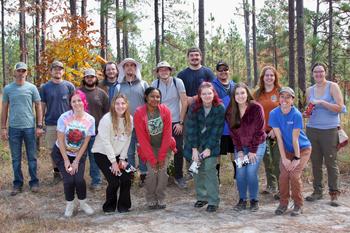
Students experienced hands-on learning when they assisted The Nature Conservancy (TNC) in collecting wiregrass seeds in Calloway Community Nature Park. Rare species of animals and plants, including federally endangered red-cockaded woodpeckers and Michaux’s sumac, inhabit the park (also called Calloway Forest Preserve). The park is undergoing habitat restoration to revitalize its longleaf pine ecosystems. Restoration strategies include prescribed fires and plantings of native vegetation, including wiregrass. Fire benefits wildlife and plantlife by keeping the landscape open, reducing competition from hardwood trees, triggering flower and seed production, and enhancing overall biodiversity. As a dominant groundcover in intact ecosystems, wiregrass helps carry fire across landscapes.
As part of their service-learning activities, students enrolled in Conservation Biology (BIO 4320) harvested several pounds of wiregrass seed, much of which will be donated to the Lumbee Tribe Cultural Center in Maxton. The tribe has partnered with TNC to start a program of prescribed fires and habitat restoration at the cultural center. Plantings with longleaf pine, wiregrass, and other native grasses are in the plans. Not only critical for restoration, longleaf pine and wiregrass also have important cultural connections, valued traditionally by the Lumbee Tribe for herbal medicines and artwork. Conservation students have partnered with the tribe in service-learning, mostly by way of biodiversity surveys of the cultural center.
The seed collection event at Calloway was open to the public for three days in November, providing wonderful occasions for TNC to engage the local community in management activities and to teach them about natural ecosystems. The Nature Conservancy’s Rhonda Sturgill organized the event, and she and fellow TNC staff member Sarah Hecocks hosted the conservation students’ brief visit.
Students were treated to beautiful autumn weather. Sassafras leaves were golden yellow. Turkey oaks leaves were bright orange and rusty red, and several pine barren gentians were in bloom with brilliant blue, funnel-shaped flowers. After clipping seeds from the scattered clumps of wiregrass, students tossed them into oversized paper bags. Light and enjoyable work. After the seeds have dried, TNC will plant them in areas of the Calloway Community Nature Park that need groundcover restoration.
Conservation Biology is one of numerous academic service-learning courses in the Department of Biology and University. Service-learning is designed to give students experiences that reach well beyond the classroom and that engage their hearts and minds in meaningful service to the community --- while learning. The UNCP Office for Community and Civic Engagement supports these courses by way of workshops, faculty-student fellowship programs, stipends, educational resources, and by facilitating community partnerships.
Conservation Biology gives special thanks to Millard Locklear of the Lumbee Tribe for connecting the class to TNC's seed collection event.